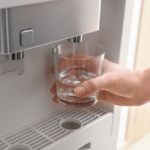Topsfield Residents told not to consume the water!
Concern over contaminated drinking water in Topsfield MA reached new levels in October 2020 when the following notice was mailed to all Topsfield Residents:
PFAS detected in our water
On October 2, 2020, the Massachusetts Department of Environmental Protection (MassDEP) promulgated a new drinking water regulation and maximum contaminant level (MCL) of 20 nanograms per Liter (ng/L) for the sum of six per- and polyfluoroalkyl substances (called PFAS6). An MCL is the maximum permissible level of a contaminant in water which is delivered to any user of a public water system. The Topsfield Water Department has been testing for PFAS monthly since July 2020. Some samples taken during this time frame had slightly elevated levels of PFAS6. We are required to provide these materials to make you aware of the elevated levels so you can make informed decisions about your drinking water. The Topsfield Water Department has not violated the drinking water regulations. A violation occurs when the average of all samples taken during a quarter exceed the MCL of 20 nanograms pper Liter (ng/L) or 20 parts per trillion (ppt). You will receive a formal notice if this occurs
What is PFAS6?
PFAS6 includes pefluorooctanioc acid (PFOA), perfluorooctane sulfonic acid (PFOS), perfluorononanoic acid (PFNA), perfluorohexanesulfonic acid (PFHxS), perfluorodecanoic acid (PFDA) and perfluoroheptanoic acid (PFHpA). PFAS are man-made chemicals that have been used in manufacturing of certain fire-fighting foams, moisture and stain resistant products, and other industrial processes.
What are the health effects of PFAS6?
Some people who drink water containing PFAS6 in excess of the MCL may experience certain adverse effects, including the liver, blood, immune system, thyroid, and fetal development. These PFAS6 may also elevate the risk of certain cancers.
What should I do?
For consumers in a sensitive subgroup (pregnant or nursing women, infants, and people diagnosed by their health care provider to have a compromised immune system) you are advised:
- Do not consume, drink, or cook with water when the level of PFAS6 is above 20 ng/L.
- Use bottled water for cooking of foods that absorb water (like pasta).
- Use bottled water for infant formula or use formula that does not require adding water.
For all other consumers not in a sensitive subgroup – You may continue to consume the water because 20 ng/L value is applicable to a lifetime consuming the water and shorter duration exposures present less risk.
If you have specific health concerns regarding your past exposure, you should see the Center for Disease Control and Prevention’s link below and consult a health professional, such as your doctor.
Steps you can take to reduce your exposure
Consider taking the following steps while we monitor, assess and address PFAS6:
- For older children and adults (not in a sensitive subgroup), the 20 ng/L value is applicable to a lifetime of consuming the water. For these groups, shorter duration exposures present less risk. However, if you are concerned about your exposure while steps are being taken to assess and address PFAS6 concentrations in the water, use of bottled water (as long as it contains less PFAS6) will reduce your exposure.
- Home water treatment systems that are certified to remove PFAS by an independent testing group such as NSF, UL or the Water Quality Association may be effective in treating the water. These include point-of-entry systems, which will treat all the water entering a home, or point-of-use devices, which treat water where it is used, such as a faucet.
Notices such as these are helpful in that they bring specific concerns to residents and suggest concrete action. However, they may also imply that the identified contaminant is the only thing in the water to worry about when often it’s not.
We know very little about what is in our drinking water and the government does not require testing/reporting for many compounds already banned in other parts of the world including the EU.
Very little regulation exists for what is allowed to be landfilled. Think about all the chemical cleaners, paints and degreasers that end up in our local landfills from your home alone. Eventually all of these chemicals make their way into the groundwater, it’s just a matter of time. If you also consider the pharmaceutical hormones that accumulate in the water system as they are excreted in urine and recycled back into the water system, it can get overwhelming.
The water departments of almost every town can be depended upon to deliver highly disinfected water to your home and test periodically against a very short list of potential contaminants. Disinfecting may kill bacteria and viruses but leave behind other, more toxic compounds. Water departments aren’t responsible for what is still being buried in the ground. They are required to disinfect the water according to EPA standards, and can’t afford the extremely high-cost water infrastructure/treatment upgrades that are needed. In the years to come it’s likely that the town of Topsfield will build the infrastructure necessary to treat the water for PFAS, however since almost everything concerning the end-quality of your water is beyond the control of any water department, it is a good time to educate yourself about how you can have healthy water in your home.
The good news is that effective and efficient systems are readily available to treat your water from TrueWaterQuality and other local water quality experts.




